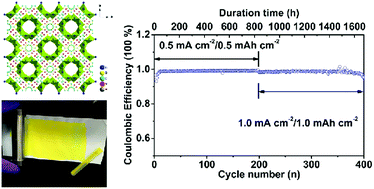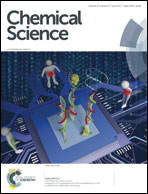Functional metal–organic framework boosting lithium metal anode performance via chemical interactions†
Abstract
Dendrite growth and low coulombic efficiency are two major factors that limit the utilization of Li metal electrodes in future generations of high-energy-density rechargeable batteries. This article reports the first study on metal–organic framework (MOF) materials for boosting the electrochemical performance of Li metal electrodes and demonstrates the power of molecular-structure functionalization for realizing desirable ion transport and Li metal nucleation and growth. We show that dendrite-free dense Li deposition and stable Li plating/stripping cycling with high coulombic efficiency are enabled by modifying a commercial polypropylene separator with a titanium-based MOF (NH2-MIL-125(Ti)) material. The NH2-MIL-125(Ti)-coated-separator renders Li|Cu cells that can run for over 200 cycles at 1 mA cm−2–1 mA h cm−2 with average coulombic efficiency of 98.5% and Li|Li symmetric cells that can be cycled at 1 mA cm−2–1 mA h cm−2 for more than 1200 h without short circuiting. The superior cycling stability is attributed to the amine substituents in the NH2-MIL-125(Ti) structure which induce increased Li+ transference numbers and uniform and dense early-stage Li deposition.

- This article is part of the themed collection: Editors’ Choice Collection


 Please wait while we load your content...
Please wait while we load your content...